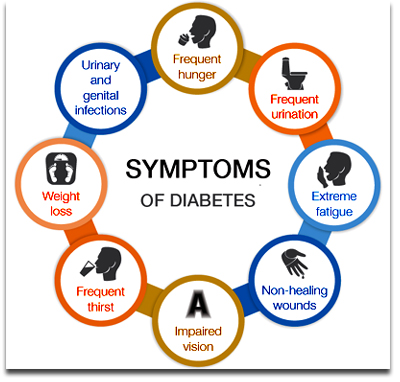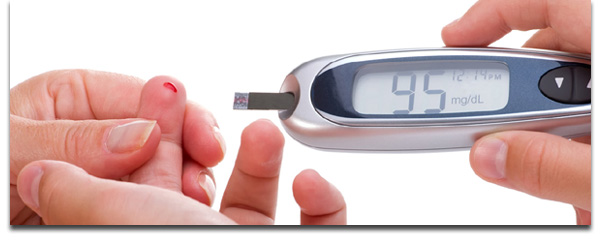Overview
 Diabetes is a long-term disorder that causes a higher level of Blood Glucose. It occurs when our body’s immune system attacks and destroys the insulin produced by beta cells of the pancreas. Insulin is a hormone that controls our blood glucose level and metabolism – a process that turns the food we eat into energy.
Diabetes is a long-term disorder that causes a higher level of Blood Glucose. It occurs when our body’s immune system attacks and destroys the insulin produced by beta cells of the pancreas. Insulin is a hormone that controls our blood glucose level and metabolism – a process that turns the food we eat into energy.
There are two main types of diabetes: Type 1 and Type 2. Type 1 diabetes is also known as juvenile or childhood diabetes because it occurs in childhood and young age. Type 2 diabetes accounts for the vast majority (around 90%) of diabetes worldwide and affects people in their 20s to 80s.
If your fasting glucose level is >126 mg/dl and your post-meal glucose level is >200 mg/dl, you may need to undertake many health tests regularly. Blood and urine testing are among the lab tests. Diabetes gets treated with changes in lifestyle, oral medicines, and injectables. Long-term uncontrolled high blood glucose levels can harm the eyes, nerves, kidneys, legs, and heart.
It needs a lifetime commitment to leading a healthy lifestyle, taking medications timely, and undergoing regular check-ups to detect complications.
Symptoms
If you have any of the following diabetes symptoms, see your doctor about getting your blood sugar tested:
- High blood sugar
- Frequest Urination
- Losing weight
- Blurry eyesight
- Depression
- Slow healing wounds
- Numb hand or feet
- Lack of interest and concentration
- Acne
- Always feel thirsty
- Dry skin
- Hair loss
- Feel hungry frequently
- Tiredness
- Blood pressure
- Weight gain
- Sexual Disorder
- Periods issue (In women)

Sometimes we take diabetes symptoms from something else because its symptoms are similar to those of many other medical conditions. Some of the False conditions include:
- Thyroid disease
- Coeliac disease
- Polycystic ovary syndrome
- Diabetes insipidus
- Pancreatitis
- Insulin resistance
- Dental problems
- Hemochromatosis
By doing blood tests we can differentiate Diabetes from other false conditions.
Lab Tests
 Lab tests are a complete analysis of your whole body. Blood tests are done:
Lab tests are a complete analysis of your whole body. Blood tests are done:
- To diagnose any kind of symptoms.
- To find out how well our organs are working.
- It can monitor chronic health conditions and diseases and find out problems in their early stages.
To Diagnose and monitor diabetes some of the following tests are :
- Kidney Function Test
- Glucose-Random Blood (RBG) Test
- Glucose-Fasting Blood (FBG) Test
- Glucose Postprandial Blood (PPBG) Test
- Glycosylated Hemoglobin (HbA1c) Test
- Complete Urine Examination
Types
- Type 1 diabetes: The exact cause of type 1 diabetes is yet unknown, though it is the body’s immune system that works to destroy harmful bacteria and viruses — mistakenly destroying the insulin-producing beta cells of the pancreas. As a result, there is no insulin production, which affects blood glucose control.
- Type 2 diabetes happens when our body cells do not respond to insulin as they should. It makes it hard for your cells to get sugar from the blood for energy. It is called insulin resistance. Your pancreas doesn’t make enough insulin.
- Prediabetes is a warning sign that you are at risk for getting type 2 diabetes.It means the blood sugar in your body is higher than the average level. but not high enough to be diabetic. Prediabetes is also called impaired glucose tolerance or impaired fasting glucose. Most people who get type 2 diabetes have prediabetes first.
- Gestational diabetes If your blood sugar level first becomes too high when you are pregnant, you have gestational diabetes. It usually goes back to normal after the baby is born. It can occur at any stage of pregnancy but is more common in the second or third trimester. Women who have had gestational diabetes are more likely than other women to develop type 2 diabetes later on. You may be able to prevent or reduce the severity of type 2 diabetes by staying at a healthy weight, eating healthy foods, and increasing your physical activity.
Risk Factors
Type 1 diabetes
- Presence of autoantibodies
- An autoimmune reaction is initiated by environmental triggers or virus
- Certain types of genes in the body
- Family history of diabetes
- Age – it usually develops in younger adults and children.
Type 2 diabetes
- Overweight or obesity
- Age
- Polycystic ovarian syndrome or Polycystic ovarian disease
- Gestational diabetes
- Pregnancy
- Stress
- Smoking
- Inactive lifestyle
Diagnosis
Diagnosis of diabetes depends on lab tests. These include :
Random Blood Glucose Test (RBG)
It is a type of blood test that measures the glucose level in the blood. RBG does not require the pre-preparation of patients. You can give blood at any time in the day. You don’t have to take fasting like other tests. If you have symptoms of high blood glucose take this test as a part of a routine preventive health check-up.
According to the American Diabetes Association guidelines for diabetes testing, the values for random blood glucose test are as follows:
- Normal: < 140 mg/dl
- Prediabetes: 140mg/dl to 200 mg/dl
- Diabetes: ≥ 200 mg/dl
Fasting Blood Glucose Test (FBG)
Most doctors prescribes a fasting blood glucose test for diagnosis of diabetes. This test measures the blood glucose level in an empty stomach(fasting state). Ideally, 10 -12 hrs of fasting required before the test. Fasting Blood Glucose test is also recommend to monitor the treatment of diabetes.
According to the American Diabetes Association guidelines for diabetes testing, the values for FBGT are as follows:
- Normal: < 100 mg/dl
- Prediabetes: 100 mg/dl to 125 mg/dl
- Diabetes: ≥ 126 mg/dl
Postprandial Blood Glucose Test (PPBG)
This test checks blood sugar level exactly 2hours after eating a meal. It usually recommended to see how our body responds to sugar and starch after a meal. Usually, the doctor prescribes Fasting blood glucose and Postprandial glucose tests together. These tests monitors treatment effects in patients undergoing diabetes treatment.
According to the American Diabetes Association guidelines for diabetes testing, the values for PPBG are as follows:
- Normal : < 140 mg/dl
- Impaired glucose tolerance (prediabetes) : 140 mg/dl to 200 mg/dl
- Diabetes : ≥ 200 mg/dl
Hemoglobin A1c Test (HbA1c)
This blood test tells us our average blood glucose level over the past 2 to 3 months. This test monitors how well is one’s glucose level with medication. However, if your fasting and postprandial levels are high, then HbA1c is advised to confirm the diagnosis.
According to the American Diabetes Association guidelines for diabetes testing, the values for HbA1c are as follows :
- Normal : < 5.7%
- Prediabetes: Between 5.7% to 6.5%
- Diabetes : ≥ 6.5%
- Pregnant women: Between 6% to 6.5%
Oral Glucose Tolerance Test (OGTT)
This test checks the blood sugar levels before and 2 hours after having a sweet drink (taken orally). This test tells the doctor how well our body reacts to glucose (sugar) which is helpful in the diagnosis of diabetes.
According to the American Diabetes Association guidelines for diabetes testing, the values for OGTT are as follows:
- Normal : <140 mg/dl
- Prediabetes : 140 mg/dl to 199 mg/dl
- Diabetes : ≥ 200 mg/dl
Treatments
Diabetes can be managed with drugs and injections, as well as some lifestyle changes. Your doctor may prescribe diabetic medications or injections based on your blood glucose level. The following are some examples of diabetes treatment:
- Oral antidiabetics
- Insulin injections
- Bariatric Surgery

